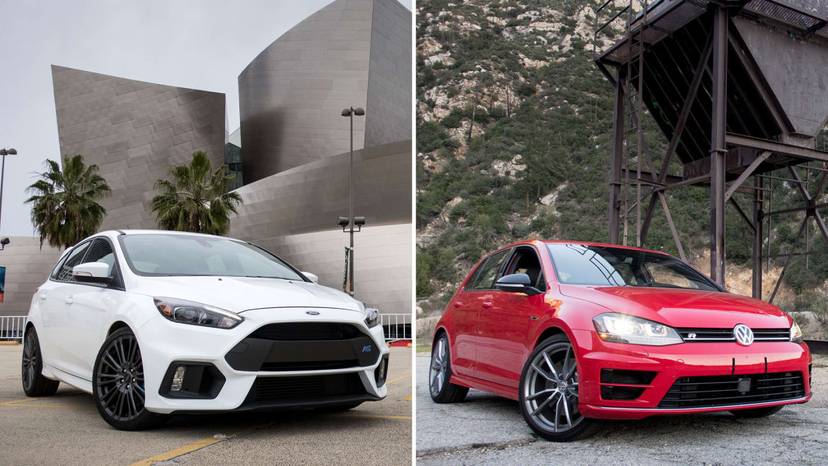
The 2017 Ford Focus RS hatchback has a singular… well, focus: Drive fast. And it accomplishes that mission, but it does so at the expense of most other attributes.
The Focus RS made its debut in 2016, the first of Ford’s RS models to make it to American shores in a long while. But now, thanks to Ford’s new global emphasis, what’s made here is sold everywhere and vice versa. And after driving the Focus RS, I’m glad it’s finally made the jump across the pond.
The 2017 Ford Focus RS returns without any notable changes for the new model year. Compare the 2017 version with last year’s model here.
Even with the mothballing of the Mitsubishi Lancer Evolution, we’ve suddenly stumbled from a performance-compact desert to an oasis of rally-inspired options. Competing with the Focus RS for hot-hatch stardom are the Volkswagen Golf R, Subaru WRX STi and the forthcoming 2018 Honda Civic Type R that’s expected this spring. Compare the Focus RS with the Golf R and WRX STi here.
I covered a lot of ground in my week with the Focus RS, from winding mountain roads to the traffic-clogged arteries of Los Angeles. And just as speed can vary on those freeways, so did my feelings about the RS.
Flashy Styling
The Ford Focus RS comes with plenty of exterior styling enhancements that ensure it will never, ever, never-ever-ever be confused with a regular Focus. It certainly looks the part of a hot hatch, with a unique grille up front that has large openings to feed more air to the engine and help cool the front brakes. Out back is a large body-colored spoiler and an aggressive rear diffuser integrating dual exhaust pipes. Nineteen-inch wheels come standard in several available designs, while a set of 18-inch wheels wrapped in winter tires is offered for those who live in colder climates.
Powertrain
The beating heart of the Focus RS is a turbocharged, 2.3-liter EcoBoost four-cylinder engine. It’s shared with the Ford Mustang, but extensive modifications here including a twin-scroll turbocharger, beefed-up cooling systems and a high-flow head. Together, they boost the engine’s output to a hearty 350 horsepower and 350 pounds-feet of torque and push its redline to a higher 6,900 rpm. There’s only one transmission, and it will please old-school enthusiasts: a six-speed manual.
EPA-estimated fuel economy is 19/25/22 mpg city/highway/combined, and premium gas is required. Good luck hitting those figures, though; this car invites you (more like begs you) to drive like a bit of a maniac.
On a Twisty Road
The shocks have two modes, Normal and Sport, the latter of which stiffens them up noticeably. A small button on the turn-signal stalk allows the driver to adjust suspension stiffness and keep all other drive settings constant in any mode. I’d recommend using the dampers in Sport only on well-maintained roads with even surfaces; any sort of rough pavement or potholes get immediately translated through the seat and rattle your brain a bit.
Get the Focus RS on a good road with twists, where it can stretch its legs a bit, and it is an absolute joy. The suspension keeps it amazingly flat in the corners (especially with the dampers in Sport), there’s oodles of grip from the wide tires, and the whole car is set up to be fast, responsive and visceral. Once the road straightens out, though, all that tautness tells a different story.
How It Drives in Traffic
It’s as if the Ford Focus RS is overly communicative: It wants you to know what’s going on around you at all times and doesn’t let you relax as a driver or passenger. That’s a good thing when you want to have some fun, but it’s just annoying in any kind of traffic or on a road that’s not well-paved. Road noise is omnipresent.
Low-Rent Interior
The Focus RS I drove came equipped with a $2,785 RS2 Package that added a powered driver’s seat, heated front seats and steering wheel, navigation and — most interestingly — leather-trimmed Recaro sport seats. The sport seats are heavily bolstered; that’s welcome when it comes to keeping the driver in place but makes it hard for larger individuals to fit. While I could stand to lose a few pounds, I’m not that big (or so I hope), but if I were any bigger, they would have been uncomfortable.
Conclusion
Put up against its two competitors, the Focus RS is the sharpest instrument. It’s faster, corners harder and has a higher performance ceiling than the Golf R or WRX STi. But if I had to drive one of those cars on a daily basis, I’m not sure the RS is the one I’d take. The Golf R rides better and has a much nicer interior, while the WRX STi splits the difference between the two.
If you can live with its foibles, the Ford Focus RS’ rewards are great. It’s a connected driving experience that many cars aspire to but can’t deliver. I hate how much I loved it.
Cars.com’s Editorial department is your source for automotive news and reviews. In line with Cars.com’s long-standing ethics policy, editors and reviewers don’t accept gifts or free trips from automakers. The Editorial department is independent of Cars.com’s advertising, sales and sponsored content departments.







































